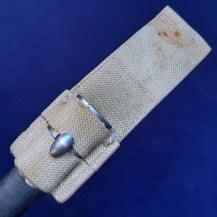British Lee Enfield 1907 Pattern Bayonet, Dated 1909 by Wilkinson, Unusual Brass Grip, Royal Air Force
Straight single-fullered knife blade, steel hilt with muzzle ring, brass slab grips secured by two flush rivets, steel beaked pommel with oil hole and locking button. Black leather No. 1 Mk 2 scabbard with steel locket & teardrop-shaped frog stud and steel chape piece. Khaki canvas frog.
The blade is stamped on one side of the ricasso with a crowned ‘E.R.’, 1907 (the pattern) ‘4 ‘09’, indicating the manufacture date of April 1909, reissue date stamps ’10, ’11, ’13 and ‘14 for 1910 etc, a faint crown inspection mark with ‘E’ from Enfield and the maker’s mark ‘Wilkinson’. On the other side it is stamped with a ‘broad arrow’ War Department stores mark, another reissue date stamp ’15 for 1915, three further crown inspection marks with ‘E’ and an ‘X’ indicating that it passed a manufacturer’s bending test.
The pommel is stamped with ‘RAF 1./3114’. This mark indicates that this bayonet was one of a number of used 1907 bayonets handed over to the newly formed Royal Air Force following WW1. Most of these bayonets were not actively used by the RAF (although a number seem to have been chromed for parade use), and were requisitioned back by the Army shortly before WW2. The scabbard is stamped at the throat ‘139’, this mark cancelled with a strikethrough, and ‘194’. The rear of the frog’s belt loop is stencilled with ‘099’.
This example would have originally been manufactured with a hooked quillon, a feature that was eliminated for 1907 Pattern bayonets made after October 1913. A number of older bayonets subsequently had the quillon removed during routine repair, and close up one can see where the hilt has been ground and refinished. The clearance hole in the pommel would also have been added at this time.
The stand out feature on this bayonet is its brass grips. It seems to have had an active service life judging by its reissue stamps (which to the best of my knowledge actually indicate some sort of armourer’s inspection was carried out), and it may be that its grips became damaged prompting an unorthodox repair job. The brass is quite well shaped to match the contours of the wood grips, its surface has been polished smooth and I believe the rivets have been brazed over then ground flush, leaving them almost invisible – note the one which has not been brazed for some reason, leaving a sunken round depression. Could be an amateur repair job, although it would seem strange to do so much metalwork when replacement wood grips are still available to this day. The blade is chrome plated – perhaps the piece was intended for parade use, and the shiny brass grips were for show? An interesting oddity.
The blade is bright, its plating slightly worn at the tip and in places along the edge, revealing clean steel. The brass grips are clean and bright with only very light patination. The leather of the scabbard is undamaged, the steel scabbard fittings have been repolished bright at some point, with some areas of later patination. The canvas frog has some slight fray to one side of the upped scabbard loop where the rivet attaches, but there is no loss of stitching or significant rubbing wear.













